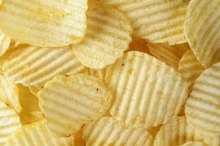Signs a Person is Detoxing Too Fast
Detoxification has been a popular method for ridding unwanted toxins accumulating in the body. Under normal circumstances of this procedure, your body will go through some undesirable effects. Luckily those symptoms usually subside after a short time. But if you detox too quickly you'll also experience some unwanted side effects. You can distinguish between the two by duration, persistence and severity.
Detoxification
There are several different detoxing regimens out there. People have chosen to fast, adopt a juice-only diet, take herbal and fiber capsules or eat only raw foods to detox their body. There are many commercial detox programs as well. The main purpose behind detox programs is to eliminate toxins and restore a healthy balance in the body. Toxins are everywhere and we breathe them in, drink unfiltered water, eat foods with chemicals and pesticides and consume over-processed foods and sugary products. These unwanted substances build up in our organs, tissues, blood and lymph system. After awhile, we can feel fatigued, develop skin, sleep and metabolic disorders.
- There are several different detoxing regimens out there.
- After awhile, we can feel fatigued, develop skin, sleep and metabolic disorders.
Normal Detoxing Symptoms
How to Tell if You Are Getting Rid of Toxins Out of Your Body
Learn More
Usually when you start to detoxify, your body goes through some normal, unpleasant symptoms. This is due to the toxins being released from your organs and body tissues. Also your immune system kicks into gear trying to eliminate these pollutants. You may feel like you're getting the flu, because:
- some symptoms include nausea
- fever
- muscle aches
- fatigue
- headaches
- thirst
- skin rashes
- diarrhea
- possibly vomiting
You may even have sleep disturbances or mood changes. This happens at the beginning of a detox and is known as the “healing crisis” and should slow down after a week or two. You may also go through withdrawals from sugar and caffeine which may also be contributing to these symptoms.
- Usually when you start to detoxify, your body goes through some normal, unpleasant symptoms.
- This is due to the toxins being released from your organs and body tissues.
Detoxing Too Quickly
You may experience fever, headaches, weakness, swollen limbs or face, faster pulse, nausea, vomiting, pain, skin rashes or eruptions if you are detoxing too fast. Since some of the symptoms for the healing crisis time are the same for symptoms of a detox going too quickly, there are some ways to distinguish between regular detoxing and abnormal symptoms 1. The main distinguishing factor is the duration. You can tell the difference between the two, because the healing crisis period should only last the first week or so. After that you should feel better than when you started the detox. If your symptoms worsen, continue after the first couple weeks or are persistent, it may indicate that you should back off a bit on the detoxing.
- You may experience fever, headaches, weakness, swollen limbs or face, faster pulse, nausea, vomiting, pain, skin rashes or eruptions if you are detoxing too fast.
- If your symptoms worsen, continue after the first couple weeks or are persistent, it may indicate that you should back off a bit on the detoxing.
What to Do
Vinegar & Epsom Salt Detox
Learn More
The best thing you can do is to drink lots of purified water or herbal tea.This will flush the toxins out of your body as well as prevent dehydration. Slow down on the detoxing a bit as well. If you're fasting to detox, you could cut the fasting down until you start to feel better and then start again slowly. Take a hot bath with some epsom salt to ease muscle pains and help you relax. Scrub your skin in the shower or bath to increase blood flow and stimulate the release of toxins. Eat fibrous foods to keep things moving through your digestive system and eliminated effectively. Rest to allow your body to recover. As a general rule, you should detox one to four times a year. You don’t want to detox too frequently as this may be very taxing on your body.
- The best thing you can do is to drink lots of purified water or herbal tea.
- If you're fasting to detox, you could cut the fasting down until you start to feel better and then start again slowly.
Related Articles
References
- Natural Therapy Pages: Detox Symptoms
- Dixon, B. (2005). “Detox”, a mass delusion. The Lancet Infectious Diseases, 5(5), 261. doi:10.1016/s1473-3099(05)70094-3
- Klein, A. V., & Kiat, H. (2014). Detox diets for toxin elimination and weight management: a critical review of the evidence. Journal of Human Nutrition and Dietetics, 28(6), 675–686. doi:10.1111/jhn.12286
- Hodges RE, Minich DM. Modulation of Metabolic Detoxification Pathways Using Foods and Food-Derived Components: A Scientific Review with Clinical Application. J Nutr Metab. 2015;2015:760689. doi:10.1155/2015/760689
- Obert, J., Pearlman, M., Obert, L., & Chapin, S. (2017). Popular Weight Loss Strategies: a Review of Four Weight Loss Techniques. Current Gastroenterology Reports, 19(12). doi:10.1007/s11894-017-0603-8
- Pankevich DE, Teegarden SL, Hedin AD, Jensen CL, Bale TL. Caloric restriction experience reprograms stress and orexigenic pathways and promotes binge eating. J Neurosci. 2010;30(48):16399–16407. doi:10.1523/JNEUROSCI.1955-10.2010
- Detox Diets and Cleanses. National Center for Complementary and Integrative Health. September 24, 2017
- Detox Diets and Cleanses. National Center for Complementary and Integrative Health. September 24, 2017
- Dixon, B. (2005). “Detox”, a mass delusion. The Lancet Infectious Diseases, 5(5), 261. doi:10.1016/s1473-3099(05)70094-3
- Hodges RE, Minich DM. Modulation of Metabolic Detoxification Pathways Using Foods and Food-Derived Components: A Scientific Review with Clinical Application. J Nutr Metab. 2015;2015:760689. doi:10.1155/2015/760689
- Hodges RE, Minich DM. Modulation of Metabolic Detoxification Pathways Using Foods and Food-Derived Components: A Scientific Review with Clinical Application. J Nutr Metab. 2015;2015:760689. doi:10.1155/2015/760689
- Klein, A. V., & Kiat, H. (2014). Detox diets for toxin elimination and weight management: a critical review of the evidence. Journal of Human Nutrition and Dietetics, 28(6), 675–686. doi:10.1111/jhn.12286
- Obert, J., Pearlman, M., Obert, L., & Chapin, S. (2017). Popular Weight Loss Strategies: a Review of Four Weight Loss Techniques. Current Gastroenterology Reports, 19(12). doi:10.1007/s11894-017-0603-8
- Pankevich DE, Teegarden SL, Hedin AD, Jensen CL, Bale TL. Caloric restriction experience reprograms stress and orexigenic pathways and promotes binge eating. J Neurosci. 2010;30(48):16399–16407. doi:10.1523/JNEUROSCI.1955-10.2010
- Gardner B, Lally P, Wardle J. Making health habitual: the psychology of “habit-formation” and general practice. The British Journal of General Practice. 2012;62(605):664-666.
- Gardner B, Sheals K, Wardle J, McGowan L. Putting habit into practice, and practice into habit: a process evaluation and exploration of the acceptability of a habit-based dietary behaviour change intervention. Int J Behav Nutr Phys Act. 2014 Oct 30;11:135.
- Wood, W, Neal, DT. Healthy through habit: Interventions for initiating and maintaining health behavior change. Behavioral Science and Policy. Volume 2, Issue 1, 2016. pp. 71-83.








